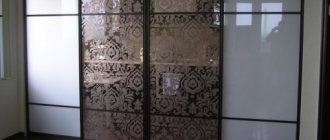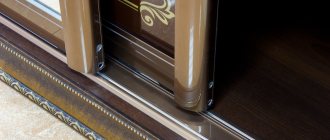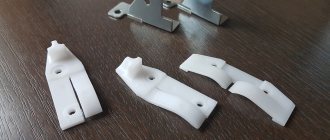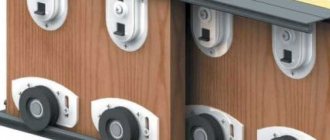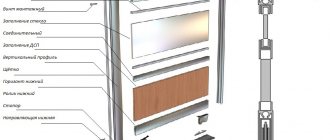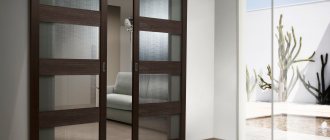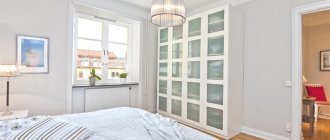Sliding door systems
You can make stylish sliding doors with your own hands.
Sliding doors differ from swing doors in the way they open. In this case, the sash moves along the facade and does not occupy additional space. The design is used both in furniture - wardrobes, and as interior doors or a screen in a niche.
Opening the sash ensures the movement of the rollers along a special guide with grooves. This method ensures ease of opening and smooth operation even with a large sash weight. On the other hand, such a mechanism presupposes the presence of technological gaps and the impossibility of a tight connection of the sash. It is installed from the wall at a distance equal to half the width of the guide, and there is no door frame at all. Therefore, the heat and sound insulation of interior sliding doors leaves much to be desired.
A big advantage of such a system is the freedom to choose material and decor. The rigidity of the door leaf is given by the frame or profile, and the vertical position is provided by the guide system itself. As a result, you can use materials for the sash that are completely unsuitable for a hinged one - polycarbonate, mirror, leather.
Suspended on the top rail
Doors on the top rail
A one- or two-way sliding system is attached to the wall at the top of the room or to the ceiling. There is no bottom rail here. The displacement is carried out due to the movement of large rollers in the upper rail. The same mechanism ensures the vertical position of the door leaf, that is, the upper carriages bear a double load.
This feature limits the choice of material. It is allowed to install light sashes of small thickness. Otherwise, the fittings fail and the door warps under its own weight. But you can’t put it too lightly: it sways in a draft.
In order for the sash to slide easily without lower rails, it is placed at some distance from the floor. Such an interior door does not provide sound or heat insulation.
Rail sliding
The two-way system includes a bottom and a top rail. The door leaf rests on the lower rollers and moves due to their movement along the grooves. The upper rollers keep the sash in a vertical position. The design, especially if it is an interior partition, is equipped with movement limiters at the bottom and stops at the top. In a wardrobe, you can do without both elements, although stoppers are usually installed.
The two-way mechanism is much more reliable and durable. Here you can install heavy doors made of solid wood, mirrors, and thick silicate glass. Another plus is better heat and sound insulation, since the mechanism includes fewer technological gaps, and the joint density can be increased due to seals.
Installing a sliding double door with your own hands is more difficult and takes more time.
If the sashes are very heavy, double guides are installed for each leaf.
Types of sliding doors
Before you start making a door, you need to decide on its type, which depends on the dimensions of the doorway and the goals pursued by installing the sliding door.
For example, if you need to divide two rooms, you can get by with two canvases moving along the partition. If it is necessary to highlight separate parts of one room, the manufacture of compartment doors is carried out from a larger number of panels with fixed or mobile doors, built by hand.
The choice of guide profile also depends on the number of panels, and the installation technology itself will be the same in both cases.
In addition to the number of panels, sliding doors differ in the type of material on which their weight depends. In production can be used:
- Solid wood;
- Laminated chipboard;
- MDF;
- Strained glass;
- Various combinations of materials.
Depending on the weight of the leaf, sliding doors are divided according to the type of sliding mechanism and the number of carriages. The greater the weight of the door, the greater the number of hanging mechanisms that must be used.
Sliding door mechanism
Sliding doors on 2 rails
The door mechanism on rollers consists of guides and rollers with carriages. The latter constitute a sliding block and are the most important element of the structure. The system is supplemented with limiters that do not allow the sash to come out of the grooves, stoppers and decorative plugs.
There are 3 options:
- Synchronous - both doors move apart in different directions, moving along the wall. Installation of the system is complex and requires a lot of effort to synchronize. The kit includes rollers, rails, hooks, cable and fastening devices.
- Telescopic - 2 or more sashes are moved to one side, covering the facade or another sashes. Each element moves on its own rail. This system is typical for a wardrobe. Disadvantage: for 2 doors you need to install 2 rails with a total thickness of 14 cm. For a three-door design, you will need a guide 21 cm wide, which is already inconvenient.
- Tram - an option for a folding model. Usually equipped with a locking mechanism.
The fittings for the mechanism are selected according to the type of construction and the weight of the sash.
Nuances of assembly and installation using the example of “Optima”
If you are interested in how to make wardrobe doors with your own hands, first of all you will need a frame system and 4 mm glass, an adjusting screw and a running profile, a carpenter's hammer and a drill with bit diameters of 6 mm and 10 mm. You can’t do without Schlegel, that is, a fleecy sealant. It is glued to the sides of the wardrobe.
Assembly begins with glass. A silicone seal is attached to the upper side, with dividers between the inserts. There is a narrow silicone seal on the glass.
Where a standard divider is installed, the upper profile of the frame is attached. A divider is installed to another mirror area. Press it tightly.
The seal is attached to the glass inserts. Finally, frame elements are placed along the width of the insert. Detailed assembly information is provided here.
Bottom profile frame
Sliding door with glass inserts assembled
For installation you will need a drill with a 5mm drill bit, a hexagon and a screwdriver, a mounting level, double-sided tape, and a mounting kit. Detailed installation information is provided here.
Advantages and disadvantages
Zoning the living room and bedroom with a sliding structure.
Sliding interior doors have many advantages:
- The sliding system saves space, since opening the sash does not require free space.
- Ease of handling: pushing even very heavy doors is easier than opening them.
- Retractable doors are used not only as interior doors. With their help, niches are blocked and the room is zoned.
- The design is much more original and varied.
There are also significant disadvantages:
- The main disadvantage is poor heat and sound insulation. There is no possibility of a tight connection between the door leaf and the wall or frame.
- A two-way system is more reliable. However, it requires mounting guides with a total width of 7 to 14 cm on the floor. Such a threshold is very inconvenient.
- The latches on this model cannot provide protection.
The variety and decorative possibilities of sliding doors compensate for the shortcomings.
Materials
The range of materials for the manufacture of door panels is varied:
- Tree. If financial capabilities allow, you can give preference to wooden door consoles. This is a good investment, because varnished wood looks simply perfect, especially between the living room and the kitchen. The door leaf can be either solid or in combination with other materials (paper, plastic, glass, mirror).
- A significant advantage of wood is its environmental friendliness and pliability, thanks to which it can be included in various interior styles. The only drawback is the massiveness of the finished products, so it is better to use door consoles in spacious kitchens. Wood often goes in tandem with glass inserts; such door options are popular and fit into any design idea.
- Glass. Designs made from glass sheets will ideally fit into the decor of a room in the style of hi-tech, minimalism or classic interior. The choice of these doors should be based on the strength and reliability of the material: how the glass reacts to sudden changes in temperature and whether it is afraid of impacts. If there are small children or animals in the house, you should use only impact-resistant fabric. The value of these doors lies in their ability to transmit light; they do not create a completely isolated space.
By choosing models of a certain dullness and color, you can achieve the required transparency of the structure. Then through the closed door it will not be visible what is happening in the adjacent room, but at the same time a certain amount of light will penetrate.
- MDF/Fibreboard is a high-quality budget material for kitchen consoles. Such doors are appropriate if it is not possible to install natural wooden panels or if the kitchen is too small and cannot withstand such door finishing. Visually, they are almost indistinguishable from their natural “colleagues”. Doors made of MDF and veneer are lightweight, do not require maintenance, and are resistant to temperature changes. A wide range of colors allows you to choose door leaves to suit any interior style.
- Plastic. Often used in conjunction with folding structures and sliding doors. The material is an economical option, but has a presentable appearance. This is the optimal solution for the kitchen space: plastic doors do not require special care; all you need to do is walk over them with a soapy cloth. If the kitchen is adjacent to the living room, such decoration of the doorway will look somewhat ridiculous and cheap.
Types of guides
Metal guides for rails
For sliding interior doors, the guide is important. It is a U-shaped profile with limiters. Its standard width is 7 cm, height – no more than 3 cm. The rail is made from the following metals:
- Aluminum is a lightweight, corrosion-resistant metal. This profile wears out little, does not require maintenance or protection, and has its own pleasant color and shine. However, its mechanical strength is relatively low. Aluminum rails are only suitable for lightweight sashes.
- Steel is stronger and more durable. They serve up to 50 years. Steel hardly wears out. However, it is prone to corrosion; in order to protect the profile from rust, the steel is coated with a layer of zinc, chrome, varnish, and polymer paint. The integrity of the coating must be monitored.
Other factors are also taken into account:
- type of roller system and opening method;
- the number of parallel moving canvases - this is how the number of guides is calculated;
- the nature of the support of the sashes - if it is a single-strip system, then the upper rail must be strengthened, as it is subjected to double load.
The bottom rail, even if it is “sunk” into the floor, remains visible. Therefore, when choosing, you need to evaluate its design.
Fittings elements
All fittings for installing sliding doors for a niche are conventionally divided into mandatory and optional elements. Optional parts include various components that expand the functionality of the sliding system. These include:
- Straight stop. The part is applicable for decorative design of the vertical part of the leaf in the area where the door structure adjoins the wall;
- Shaped stop. Used in framing the upper part of the canvas or opening as an additional wall of chipboard sheets;
- U-shaped profile. Used to decorate the end part of the product.
The list of required elements installed on interior sliding doors in a niche contains quite a lot of various details. These include the side handle posts, which have several types of design, guide profiles of the upper and lower orientation, as well as door frames.
Roller systems of any of the available types can be installed as moving elements:
- Symmetrical;
- Asymmetrical;
- Lower support mechanism with adjustment function.
For long-term and effective use of the entire structure, silicone seals and tape-staples must be installed. The main functions of these products are to soften vibrations and shocks when using the structure. In addition, seals help protect the internal contents of the resulting cabinet from dust accumulation.
Mounting options
Cassette door design
Parallel sliding doors can be installed in different orders. This affects the design of the mechanism and the material of the valves.
Sliding doors
The most famous option. The sash moves along its guide in both directions. If the structure has two doors, the doors move towards each other. They have a common guide. This is the best option for simple interior doors, since only 1 rail will have to be mounted on the floor, and its width is only 7 cm.
Cassette
With this opening mechanism, the doors look much more interesting. When opened, the sash moves not along the wall, but inside it. To do this, a cavity is formed in the septum. If this cannot be done, a false wall is built. In this case, the sash actually moves along the real wall, but is hidden from view in the plasterboard box.
The design can be one- or two-door.
Cascade
Implement a telescopic opening mechanism. Each leaf moves along its own guide in one direction. For a two-door design you need to install 2 rails, and for a three-door design - 3.
Cascading doors are more suitable for wardrobes. However, with a complex configuration of adjacent rooms - a box on one side, a large difference in the thickness of the walls and interior partitions - this option turns out to be more convenient.
Types of structures
Interior sliding doors have the same essence, but their operating mechanisms are somewhat different:
- Standard. They are classified into single-leaf and double-leaf. Single-leaf doors (have one movable leaf) are best used for small rooms with tiny openings. This saves valuable space. Double doors (two movable leaves) are relevant for spacious rooms with wide openings. Both doors open in different directions, which is not only comfortable, but also makes the interior welcoming.
- Radial. It is a system in which the doors move not in a straight line, but in an arc. This is a non-standard design of a doorway, which is relevant in a room with round or curved walls.
- Accordion doors . The principle of operation of the mechanism is more reminiscent of blinds. The design consists of several narrow doors that fold into an accordion to free passage. Therefore, they are more often called folding door systems. A significant advantage is the mobility of the partition: the width of the opening can be varied at will from a narrow slot to a full passage.
- Coupe. The mechanism is similar to the systems used in wardrobes. This is the most popular solution for decorating a door partition, helping to save space in the passage between the room and the kitchen. The trick of the design is that it not only performs its direct function, but also plays the role of a wall in the room. To comfortably place furniture standing close to the walls and to the side of the doorway, use a mechanism with two leaves.
- Pencil door . Apartments equipped with a wide passage to the kitchen without walls allow the installation of a “pencil” system. A hollow plasterboard partition with a hole on the side is installed for it, which will act as a false wall and occupy part of the doorway. When the door is opened, the panel will be hidden inside the plasterboard structure.
Additional space appears along the wall to accommodate kitchen furniture. The hollow partition can be used for various household needs, such as hanging accessories or kitchen cabinets. The mechanism looks laconic in the interior and is practical to use.
Articles on the topic (click to view)
- Metal kitchen rack for appliances
- Instructions for the electric stove “classic plus”
- How to choose an electric stove with 4 burners and an oven for the kitchen
- Sofa in the bay window for the kitchen
- Lighters for gas stoves
- Small enamel kitchen sink
- Electric Turk with automatic shut-off when boiling
- Pendulum. It is used if the kitchen opening is adjacent to a narrow corridor. The uniqueness of the mechanism lies in the process of turning the door leaves: they not only move in both directions in relation to the frame of the doorway, but also rotate along the vertical axis. More often, only one door is used, opening both inward and outward.
DIY installation
To install a door made of chipboard, polycarbonate, plastic panels, you don’t have to resort to the help of specialists, but follow the instructions. The main condition is to give the sash a vertical position. Therefore, in addition to a screwdriver, hammer, chisel, you need to prepare a building level and plumb line.
First of all, the upper guide is mounted to the wall.
Installation diagram:
- The profile is cut: the bottom guide for a single-door structure should be 2 times the width of the doorway. Install so that the sash completely clears the opening when opening. At the same time, on the other side, 50 mm is left near the opening.
- For a door structure, the guide is mounted so that its middle coincides with the center of the opening.
- Holes for dowels are drilled through the rail in the floor. Insert dowels and fix fasteners.
- Determine the position of the upper guide. To do this, install a canvas in the bottom rail and mark its edge on the wall. Add 70 mm to the value and make a mark; use a building level to check the horizontalness.
- A wooden beam with a cross-section of at least 50*50 cm is fixed at the mark. The upper rail is attached to it from below in the same way as the lower one.
- Install stoppers and other additional elements.
- The door leaf assembled according to the drawing is inserted into the guides: first in the upper rail, since the upper rollers are pressure rollers, then in the lower one. Check the vertical position and freedom of movement.
- A decorative strip is attached that covers the beam and the upper guide.
It is recommended not to immediately secure the top rail tightly. If the sash moves poorly, you can correct its position by changing the position of the upper rail. Final fixation is performed after achieving free displacement.
Features of installing interior sliding doors
It is advisable to decide on a specific model and the method of opening it at the initial stage of repair in order to properly prepare the opening for it. In this case, you need to take into account the appearance of the selected model.
Thus, stained glass or all-glass sliding partitions are very fragile. If there are small children in the family, then it is better to choose the “pencil case” installation method. This will not only preserve the sliding canvas, but also protect small household members from possible injuries.
Before starting installation work, you need to level the floor and decide on its finishing coating (it affects the height of the opening).
Installation in a pencil case
There are no universal sizes; the niche is prepared individually for a specific model.
- Niche arrangement. Its size should be such that the peeled-off canvas partially peeks out (so that it is convenient to grab onto it and close it). At the same time, protruding parts (handles, decor) should not cling to the walls of the niche when opening. It is also worth considering the weight of the structure and, if necessary, pre-strengthen the part of the wall on which the upper guide will be mounted.
- Preparing the opening. With this installation method, the presence of a hatch is mandatory. Therefore, the opening is prepared with a reserve. So for a canvas 2000x700 mm, the opening should be 2100x800 mm.
- Installation of guides. In some cases, the bottom rail (if necessary) is lowered and mounted into the floor. This design turns out to be more practical, and this design looks more interesting. True, this point needs to be thought through at the stage of leveling the floor.
- Hanging the canvas. You need to be vigilant to ensure that the gaps are minimal, but that the canvas does not rub against the frame when moving.
Zoning using retractable doors is done using a similar method, only niches are made on both sides.
Installation "coupe"
Compartment doors are easier to install. If the installation is planned complete with a hatch, then the opening is prepared in the same way. If there is only a canvas on guides, then the opening should be slightly smaller than the canvas (so that it completely covers the passage).
Otherwise, installation is similar to installation in a “pencil case”.
Not too expensive models can make quite loud sounds when moving. To get rid of the rumble, you need to place a rubber band at the mounting points of the guides before installation. It will smooth out vibrations, thereby hiding the noise.
Installation of plastic doors
Such structures are often installed to separate the kitchen and the terrace or balcony. The system is completely similar to conventional plastic windows, but the structure of the hinges and locks is such that, in addition to the standard tilt-and-turn mechanism, the entire structure can be moved, like a folding accordion.
Installation and adjustment of such mechanisms is carried out only by professionals, otherwise the doors will not function properly.
Homemade sliding doors
Even an ordinary door can be made into a sliding one.
For a door weighing more than 30 kg, it is necessary to make upper and lower guides
Manufacturing recommendations:
- If the door leaf weighs less than 30 kg, you can install a hanging system. If it’s more, they install a two-lane one.
- An interior door made of chipboard often has decorative inserts or overlays. If they cannot be removed, their size must be taken into account when determining the location of the bottom rail. Otherwise, the sash will not be able to fit onto the wall.
- The usual fittings are removed. It is inconvenient to move the sash using the round handle.
- Accessories are purchased taking into account the weight of the product. Door handles – taking into account the design.
- The material is preferably light but durable: chipboard, MDF, polycarbonate. Mirrors and glass are much harder to work with.
- The balance of a regular sash is not designed for this type of use. To compensate for this, the rollers are placed as far apart as possible to ensure a smooth ride.
Sliding doors are practical and convenient. They do not take up space when opened, are very decorative and easy to use. However, their heat and sound insulation performance is lower than that of swing doors.
Manufacturing of sliding doors
After the difficult choice of design and material for the sliding door, you can begin to manufacture and install it.
Preliminary measurements
Before purchasing all the elements of a compartment door required for installation with your own hands, it would be a good idea to watch a video or consult with friends who have ever encountered such work. This will help you avoid mistakes when purchasing and save time on correcting them.
First, you need to take measurements of the doorway with maximum accuracy using a tape measure, preferably at several points in width and height. The width and height of the door leaf (if it is the only one) must exceed the corresponding dimensions of the opening by 5-6 cm. When installing several leaves, their total width is calculated taking into account the fact that they will slide one after another and move apart.
Tools and materials
In order to make compartment doors with your own hands, you need to prepare the following tool in advance:
- Screwdriver;
- Roulette;
- Plumb;
- Pencil;
- Level;
- A chisel or hand milling machine.
Materials you will need:
- Fasteners and door fittings;
- Beam 50x50 mm;
- Anchors for attaching timber to the wall;
- Platbands, extensions, door frame.
When purchasing ready-made doors, all necessary fittings, fastening and sliding elements are already included in the delivery package. But in order to make compartment doors with your own hands, you need to purchase them separately; they are available in almost any hardware store.
A wooden block will be needed to secure the guide to the wall. Its length is taken to be equal to the width of the door leaf multiplied by two. If there is no doorway as such and the door is installed as high as the ceiling, then the guide should be fixed directly to the ceiling.
The frame is a frame framing the opening to which the door leaf is adjacent in the “closed” state. Platbands and extensions will be required to decorate the opening and hide the fastening elements.
Preparatory work
During rough finishing, only the sliding systems themselves can be installed if the door is planned to be hidden in a niche built into the wall when opening. In all other cases, installation of the system should be carried out only after the premises have been finished.
Do-it-yourself installation of compartment doors cannot be started without checking the correct contours of the opening. The walls must be vertical and run strictly parallel to each other. If these conditions are not met, you must try to fix the opening.
If the door is planned to be installed in the opening of a plasterboard partition, then during installation a timber frame should be secured above it.
